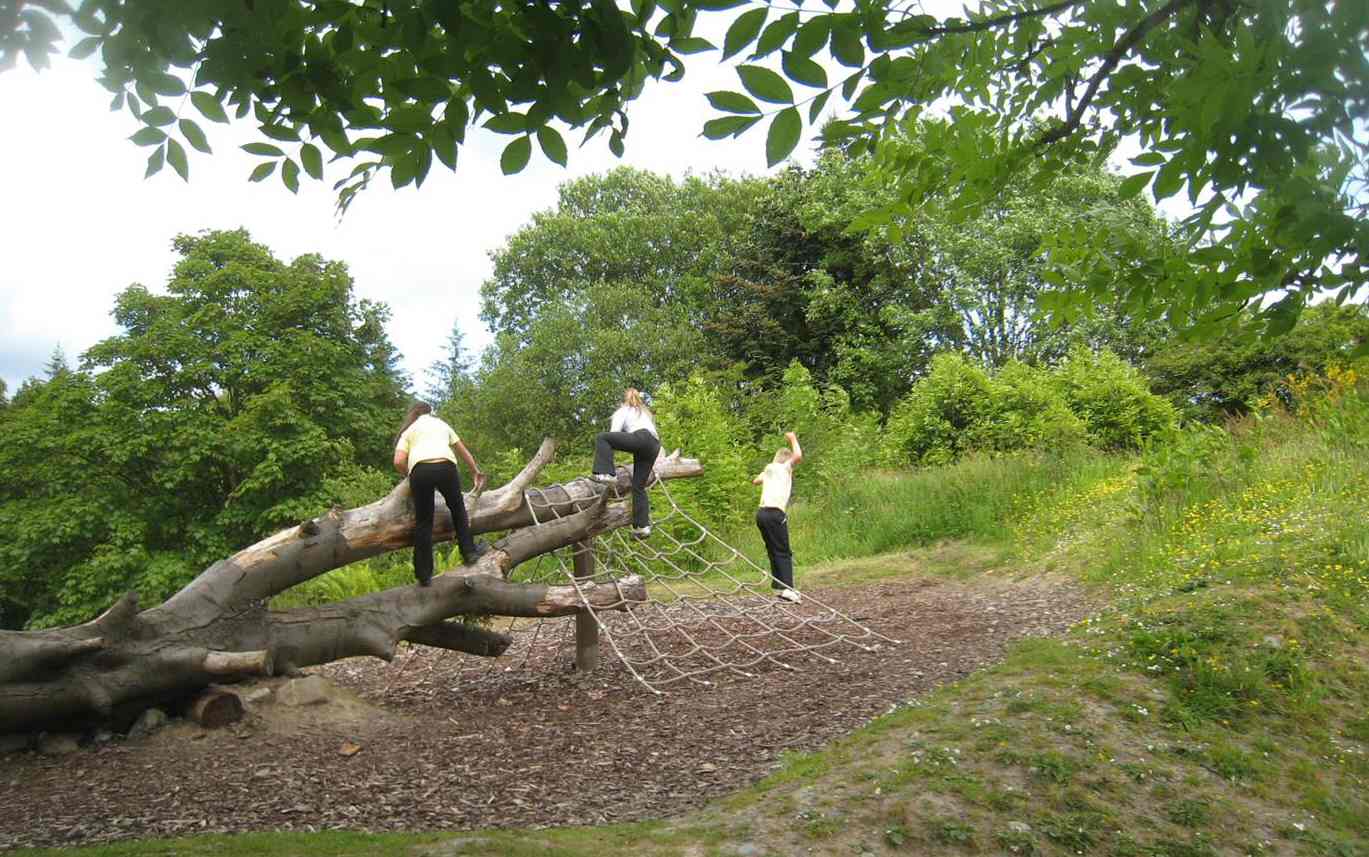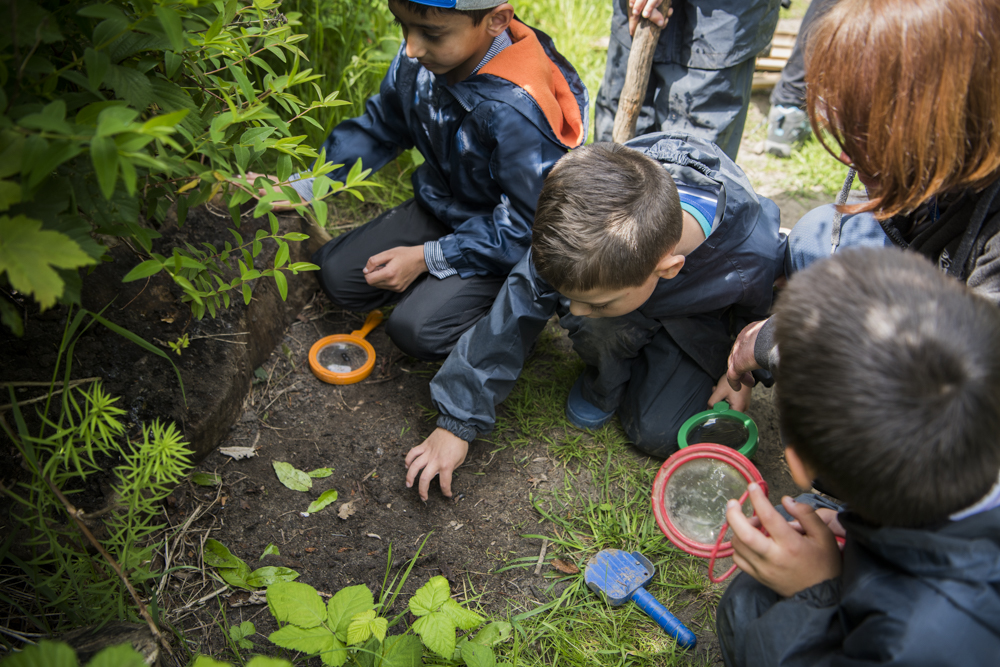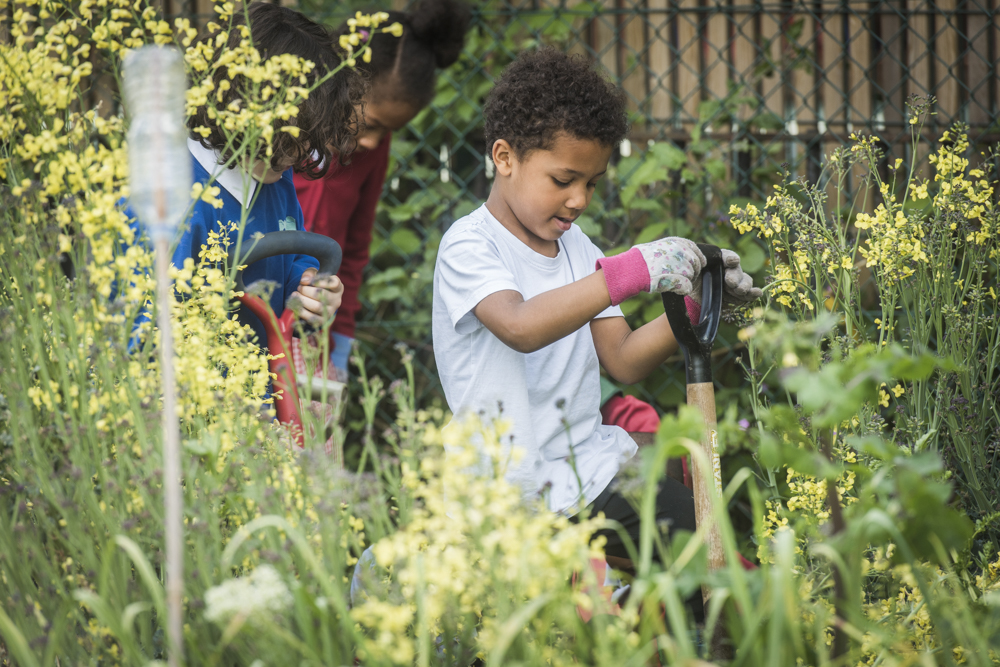- Home
- Public Benefits
- Gardening & people
- Education
- Education evidence
Education benefits
Contact with nature also improves childrens' formal and informal learning. Learning outdoors is a richer, more direct experience and usually much more fun. One 2007 report showed children exposed to nature in the countryside scored higher on concentration and self-discipline, improved their awareness, reasoning and observational skills, did better in
reading, writing, maths, science and social studies, were better at working in teams; and showed improved behaviour overall. Outdoor learning boosts education in four ways:
- Cognitive Impacts (greater knowledge and understanding)
- Affective Impacts (attitudes, values, beliefs and self-perceptions)
- Interpersonal and Social Impacts (communication skills, leadership and teamwork)
- Physical and Behavioural Impacts (fitness, personal behaviours and social actions.
- they simply learn more willingly and better, and this is especially valuable for under-achievers.
Environmental benefits
If the next generation of adults is to care about and protect the natural environment, they must build a connection with it as a child, and they are most open to building an interest in nature before 12 years of age. As David Attenborough has said:
"No one will protect what they don’t care about; and no one will care about what they have never experienced" |
It may already be too late. Britain has a proud history of talented amateur naturalists, but these skills are now rare in younger people. Most competent naturalists are now in their 60's, and most "A" level candidates can only identify on average 3 wild plants. If this abandonment of practical "natural history skills" continues, society will find it impossible to cope with the challenges of climate change and biodiversity decline.
The barriers to outdoor experience
In its "Reconnecting people and nature" section the 2011 UK Government White Paper, "The Natural Choice: securing the value of nature" pledged to exploit ‘nature’s health service’ for children’s physical and mental health, to increase outdoor learning, and create better neighbourhood access to nature. Unfortunately nothing much has changed.
There are however a number of barriers to outdoor learning in addition to the obvious resource needs of cash and trained personnel:
- Parental concern over of traffic accidents confine children to the home
- Unwarranted fears over risks outside the home. Overwhelmingly, most accidents occurr within the home. but this isn't recognised by parents who assume that the outside environment is full of threats.
- Stranger danger. The very rare but horrendous cases of harm to children by strangers attracts so much press coverage that parents perceive it to be an everyday occurrence and strictly limit their offsprings' autonomy out of doors. In reality, the overwhelming danger is from people within the extended family circle.
- Over-cautious attitudes by teachers, police and others banning what they perceive as risky activities such as climbing trees or even playing tag, often only to protect themselves from criticism.
- Some conservationists and environmental educators have a very over-protective attitude to the plants and animals on their reserves. Children are told to stand back, not to pick up or collect what they see and not to interact in any meaningful or memorable way. which if permitted could promote understanding and respect.
Resources available from this page
Wildlife gardening, nature and education – the evidence reviewed 28 pages, 80 references cited
Download our guide How to: Garden for wildlife with children
Page written by Ruth Staples-Rolfe (Learning Through Landscapes) and Steve Head
Evidence base for engaging children in
wildlife gardening
|
Percentage of children playing in
different areas
|
Modern children
|
Parents'
generation
|
Grandparents'
generation
|
|
At own or friends home
|
83%
|
78%
|
73%
|
|
In local streets
|
40%
|
74%
|
80%
|
|
School playground
|
40%
|
64%
|
58%
|
|
House garden
|
75%
|
78%
|
73%
|
|
Woods
|
10%
|
44%
|
52%
|
|
Heath, field, farmland
|
9%
|
39%
|
49%
|
|
Riverside, canalside, pond
|
7%
|
22%
|
33%
|
|
Mountains, moorland, wild places
|
4%
|
11%
|
18%
|
There is plenty of evidence that modern children are losing unsupervised - or any - contact with nature, and it is being replaced by play in the home, especially with electronic media. At the same time, the very significant benefits outdoor play and experience bring to the physical and mental health of children, their socialisation, and their learning are becoming clear. Contact with nature as children predisposes the adult to awareness, concern and action about the environment.
This page provides only an outline summary of the evidence.
A much more complete review, with references to the literature is provided in our pdf document here.
Useful sources
We would like to point readers towards some key information sources from which we are quoting
Natural Childhood by Stephen Moss, a report for the National Trust in 2012 that looks at childrens' detachment from nature and what benefits nature brings.
Childhood & Nature: A survey on changing relationships with nature across generations. A detailed report by Natural England on the decline in children's abibility to play out of doors
Sowing the Seeds Report, Reconnecting London's Children with Nature This report was commissioned by the London Sustainable Development Commission to look at how London's children could reconnect with nature.
The benefits of forest schools experience in their early years by Sam Massey. Woodland has a huge value for children as well as wildlife. Sam Massey is a Early Years Mentor Teacher for Worcester Local Education authority and published a report into the value of forest schools in early years settings
Learning outside the classroom Ofsted. This 2008 report has a strong Ofsted perspective but demonstrates the importance of using a range of contexts for outside learning including in the natural environment.
Isolation from nature
The "Natural Childhood" report written by television producer and author Stephen Moss is an excellent introduction to the evidence that we as a nation, and especially our children, are exhibiting the symptoms of a modern phenomenon known as ‘Nature Deficit Disorder’. This (not yet medically recognised) term was coined by American Richard Louv in his 2005 (revised 2008) book "Last Child in the Woods":
"Nature Deficit Disorder describes the human costs of alienation from nature, among them: diminished use of the senses, attention difficulties, and higher rates of physical and emotional illnesses" |
Children today do not explore their environment in person, they are increasingly at home only in the digital world. They watch television for 17 hours, and are online for 20 hours every week. Our 11–15-year-olds spend half their waking lives in front of a screen. This replacement of play in the real world with virtual play has been called ‘the extinction of experience’, and the over protective life of childen indoors has been called ‘well-meaning, protective house arrest’. This is in marked contrast to the outdoor childhood experienced by their parents, and especially their grandparents.
Health
Linked to this we are observing rising health and fitness problems. About a third of 2-15 year-olds children in England are now either overweight or obese, and at this rate by 2050 more than half of all adults and a quarter of all children will be obese. Other related problems include short-sightedness, asthma and vitamin D deficiency, which is leading to a reappearence of the childhood disease rickets which can be prevented by exposure to sunlight out of doors.
Children’s ability to do physical tasks such as sit-ups has declined, and there has been a 10% drop in their cardiovascular fitness in a decade. Moss notes similar disturbing trends in child mental health, with 10% of 5-16 year olds having a clinical mental health disorder, and 35,000 taking antidepressants.
Cosseted indoor children are also missing out on building resilience through coping with the risks and challenges of outdoor play, perhaps creating a generation of unimaginative and un-enterprising adults.
The best way to get children to exercise is to give them opportunities to play outside - here is a quotation from playworker Penny Wilson:
"If you watch a child playing outside they’re just doing so many physical tasks – they run for hours, dig, climb. If you told them to do it they wouldn’t, but they want to because they’re playing. You won’t get that level of physical activity with anything else" |
Exercise habits learned young persist through life and have even been shown to influence longevity. Mental health also benefits from outside play and exploration, reducing stress and aggresion, and boosting self-esteem. The modern phenomenon of Attention Deficit Hyperactivity Disorder (ADHD) can be be reduced threefold by increased contact with nature compared with staying indoors.


Learning out of doors is so much more fun
Learning out of doors is so much more fun
Education benefits
Contact with nature also improves childrens' formal and informal learning. Learning outdoors is a richer, more direct experience and usually much more fun. One 2007 report showed children exposed to nature in the countryside scored higher on concentration and self-discipline, improved their awareness, reasoning and observational skills, did better in
reading, writing, maths, science and social studies, were better at working in teams; and showed improved behaviour overall. Outdoor learning boosts education in four ways:
- Cognitive Impacts (greater knowledge and understanding)
- Affective Impacts (attitudes, values, beliefs and self-perceptions)
- Interpersonal and Social Impacts (communication skills, leadership and teamwork)
- Physical and Behavioural Impacts (fitness, personal behaviours and social actions.
- they simply learn more willingly and better, and this is especially valuable for under-achievers.
Environmental benefits
If the next generation of adults is to care about and protect the natural environment, they must build a connection with it as a child, and they are most open to building an interest in nature before 12 years of age. As David Attenborough has said:
"No one will protect what they don’t care about; and no one will care about what they have never experienced" |
It may already be too late. Britain has a proud history of talented amateur naturalists, but these skills are now rare in younger people. Most competent naturalists are now in their 60's, and most "A" level candidates can only identify on average 3 wild plants. If this abandonment of practical "natural history skills" continues, society will find it impossible to cope with the challenges of climate change and biodiversity decline.
The barriers to outdoor experience
In its "Reconnecting people and nature" section the 2011 UK Government White Paper, "The Natural Choice: securing the value of nature" pledged to exploit ‘nature’s health service’ for children’s physical and mental health, to increase outdoor learning, and create better neighbourhood access to nature. Unfortunately nothing much has changed.
There are however a number of barriers to outdoor learning in addition to the obvious resource needs of cash and trained personnel:
- Parental concern over of traffic accidents confine children to the home
- Unwarranted fears over risks outside the home. Overwhelmingly, most accidents occurr within the home. but this isn't recognised by parents who assume that the outside environment is full of threats.
- Stranger danger. The very rare but horrendous cases of harm to children by strangers attracts so much press coverage that parents perceive it to be an everyday occurrence and strictly limit their offsprings' autonomy out of doors. In reality, the overwhelming danger is from people within the extended family circle.
- Over-cautious attitudes by teachers, police and others banning what they perceive as risky activities such as climbing trees or even playing tag, often only to protect themselves from criticism.
- Some conservationists and environmental educators have a very over-protective attitude to the plants and animals on their reserves. Children are told to stand back, not to pick up or collect what they see and not to interact in any meaningful or memorable way. which if permitted could promote understanding and respect.
Resources available from this page
Wildlife gardening, nature and education – the evidence reviewed 28 pages, 80 references cited
Download our guide How to: Garden for wildlife with children
Page written by Ruth Staples-Rolfe (Learning Through Landscapes) and Steve Head
There is plenty of evidence that modern children are losing unsupervised - or any - contact with nature, and it is being replaced by play in the home, especially with electronic media. At the same time, the very significant benefits outdoor play and experience bring to the physical and mental health of children, their socialisation, and their learning are becoming clear. Contact with nature as children predisposes the adult to awareness, concern and action about the environment.
This page provides only an outline summary of the evidence.
A much more complete review, with references to the literature is provided in our pdf document here.
Useful sources
We would like to point readers towards some key information sources from which we are quoting
Natural Childhood by Stephen Moss, a report for the National Trust in 2012 that looks at childrens' detachment from nature and what benefits nature brings.
Childhood & Nature: A survey on changing relationships with nature across generations. A detailed report by Natural England on the decline in children's abibility to play out of doors
Sowing the Seeds Report, Reconnecting London's Children with Nature This report was commissioned by the London Sustainable Development Commission to look at how London's children could reconnect with nature.
The benefits of forest schools experience in their early years by Sam Massey. Woodland has a huge value for children as well as wildlife. Sam Massey is a Early Years Mentor Teacher for Worcester Local Education authority and published a report into the value of forest schools in early years settings
Learning outside the classroom Ofsted. This 2008 report has a strong Ofsted perspective but demonstrates the importance of using a range of contexts for outside learning including in the natural environment.
Isolation from nature
The "Natural Childhood" report written by television producer and author Stephen Moss is an excellent introduction to the evidence that we as a nation, and especially our children, are exhibiting the symptoms of a modern phenomenon known as ‘Nature Deficit Disorder’. This (not yet medically recognised) term was coined by American Richard Louv in his 2005 (revised 2008) book "Last Child in the Woods":
"Nature Deficit Disorder describes the human costs of alienation from nature, among them: diminished use of the senses, attention difficulties, and higher rates of physical and emotional illnesses" |
Children today do not explore their environment in person, they are increasingly at home only in the digital world. They watch television for 17 hours, and are online for 20 hours every week. Our 11–15-year-olds spend half their waking lives in front of a screen. This replacement of play in the real world with virtual play has been called ‘the extinction of experience’, and the over protective life of childen indoors has been called ‘well-meaning, protective house arrest’. This is in marked contrast to the outdoor childhood experienced by their parents, and especially their grandparents.

Health
Linked to this we are observing rising health and fitness problems. About a third of 2-15 year-olds children in England are now either overweight or obese, and at this rate by 2050 more than half of all adults and a quarter of all children will be obese. Other related problems include short-sightedness, asthma and vitamin D deficiency, which is leading to a reappearence of the childhood disease rickets which can be prevented by exposure to sunlight out of doors.
Children’s ability to do physical tasks such as sit-ups has declined, and there has been a 10% drop in their cardiovascular fitness in a decade. Moss notes similar disturbing trends in child mental health, with 10% of 5-16 year olds having a clinical mental health disorder, and 35,000 taking antidepressants.
Cosseted indoor children are also missing out on building resilience through coping with the risks and challenges of outdoor play, perhaps creating a generation of unimaginative and un-enterprising adults.
The best way to get children to exercise is to give them opportunities to play outside - here is a quotation from playworker Penny Wilson:
"If you watch a child playing outside they’re just doing so many physical tasks – they run for hours, dig, climb. If you told them to do it they wouldn’t, but they want to because they’re playing. You won’t get that level of physical activity with anything else" |
Exercise habits learned young persist through life and have even been shown to influence longevity. Mental health also benefits from outside play and exploration, reducing stress and aggresion, and boosting self-esteem. The modern phenomenon of Attention Deficit Hyperactivity Disorder (ADHD) can be be reduced threefold by increased contact with nature compared with staying indoors.

Evidence base for engaging children in
wildlife gardening
Ruth Staples-Rolfe (Learning Through Landscapes) and Steve Head
|
Percentage of children playing in different areas
|
Modern children
|
Parents'
generation
|
Grandparents'
generation
|
|
At own or friends home
|
83%
|
78%
|
73%
|
|
In local streets
|
40%
|
74%
|
80%
|
|
School playground
|
40%
|
64%
|
58%
|
|
House garden
|
75%
|
78%
|
73%
|
|
Woods
|
10%
|
44%
|
52%
|
|
Heath, field, farmland
|
9%
|
39%
|
49%
|
|
Riverside, canalside, pond
|
7%
|
22%
|
33%
|
|
Mountains, moorland, wild places
|
4%
|
11%
|
18%
|














